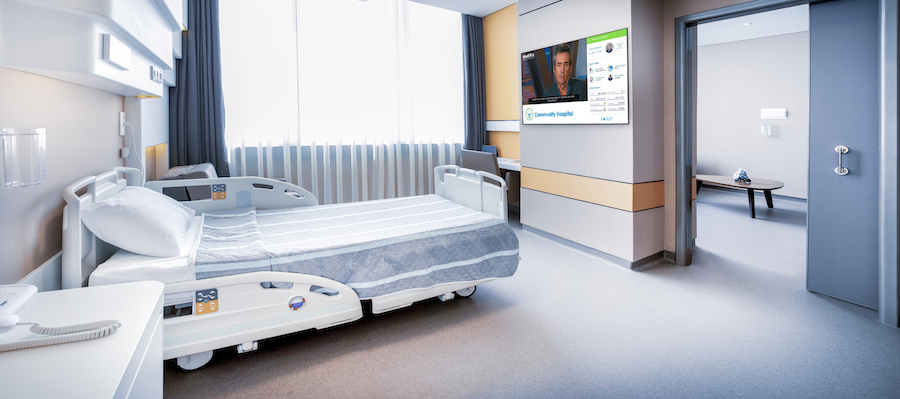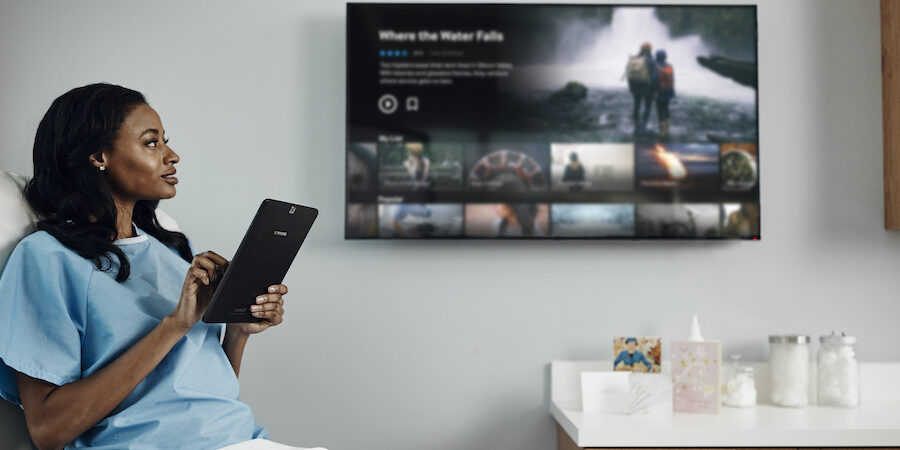Many inpatients suffer from anxiety, and that stress can impair their clinical outcomes and experience of care. This is reinforced by ample medical research, including a 2023 study in the National Library of Medicine that concluded anxiety and other psychological stress are associated with poorer inpatient outcomes. That’s echoed in a 2022 study in Scientific Reports, which showed an increase in postoperative complications in patients experiencing anxiety.
One way to alleviate patient anxiety and foster better outcomes is to use digital signage. That’s because some of the anxiety patients experience stems from unfamiliar environments and fear of the unknown. Digital whiteboards and other signage can help address this problem.
Let patients know what to expect
A digital whiteboard that spells out what to expect and when can help reduce the stress patients feel in the hospital. Especially for patients in long-term recovery, it can be reassuring to look at a display and know what’s on the agenda for each day. Research published in BMJ Quality & Safety found that being able to see the daily plan — meals, medicine, physical therapy, lab work, visitors — helped them feel more comfortable, increased their understanding and made it easier to ask questions.
Unfortunately, conventional dry-erase whiteboards require constant manual revision and cleaning — which doesn’t always happen. Too often, they are out of date, smudged, inaccurate or simply illegible. Replacing them with digital displays makes it easier to customize and update information, including their most recent vital signs. These digital displays update automatically — often based on data from the patient’s electronic health record and shift-assignment software. Because they know it’s current and correct, patients are less anxious about what to expect.
Update the patient care team
Part of knowing what to expect in a hospital is understanding who is on the patient care team and what role they play. One way to communicate this to the patient is through real-time location services, which can be connected to the digital screen. This way, when any member of the care team enters the room, their name and role will appear on the patient room TV, thanks to an employee badge that automatically connects to it.
Create the patient room of the future — today
Explore key technologies for enhancing patient experience and care while supporting staff. Download Now
Furthermore, when nurses, doctors and other members of the care team are updated in the electronic medical record platform, the info gets sent directly to the digital whiteboard in the patient’s room, so there’s no question about who is on the team.
Foster eye-to-eye communication
Regular computer screens often separate the care team from the patient, most often by simply creating a physical barrier between them. That means doctors can stay hidden behind a computer or be looking more at a screen than the patient themselves. Not only can this give the impression to the patient that they are more a digital record than a human being, but it may also close down communication as a result, affecting outcomes.
Instead, use digital whiteboards to foster that personal connection through smart patient room design and placement. Mounting the digital display above the patient’s head, to the side of the bed or on an arm attached to the ceiling lets healthcare providers maintain eye contact with patients while, at the same time, accessing necessary information. That creates a more personalized experience for the patient.
Communicate patient risks and preferences
It’s not just patients and their families who need this information. Both in and outside the room, digital whiteboards can help inform and update the care team about the status of the patient, risk factors, complications, medicine, allergies and a range of preferences. That’s important because a knowledgeable and confident staff helps reduce patient anxiety.
Educate patients on treatment
These digital tools also provide patient education — an important element in improving outcomes. For example, a study in the Journal of Diabetes Investigation reports that an inpatient diabetes education program improved both quality of life and glycemic control for 12 months after discharge. The importance of in-patient education is also emphasized by the National Library of Medicine.
Digital technology allows providers to deliver educational content about a patient’s health conditions and treatments. Using healthcare TVs with an Interactive Patient Care platform can help patients better understand what their care plan entails and why. For example, through Samsung Smart Healthcare TVs, patients have access to videos about their condition and can participate in interactive educational activities at their convenience.
Less anxious, more informed patients
By providing clear and up-to-date information about daily activities, care team members and medical conditions, these digital tools help reduce anxiety and give patients a sense of control and understanding. Furthermore, they facilitate efficient communication among the care team, keeping members well-informed about the patient’s status. All of this leads to improved patient experiences and health outcomes.
Discover more ways to secure healthcare data at the hospital in this free white paper. Also, learn more about how digital signage is transforming the patient experience.








